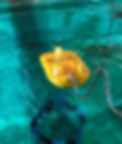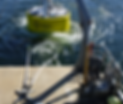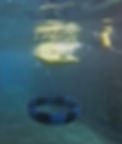
Triton WEC
Oscilla Power’s Triton wave energy converter (WEC) is a multi-mode,
two-body point absorber with four key advantages over other WECs:
MULTIMODE
ENERGY CAPTURE
Triton’s three-tendon architecture provides a unique ability to capture energy from the ocean in all six degrees of freedom (heave, pitch, surge, roll, and yaw) enabling power to be produced across a very wide range of wave conditions. The optimized surface float geometry and ring-shaped reaction structure works together to amplify this effect and increase generated power.
LOW COST
"TOW AND DROP" INSTALLATION
Because the Triton uses flexible tendons to connect the float to the submerged reaction ring, this allows the system to be installed quickly by readily available marine vessels. These self-deployment functions remove the need for specialized vessels or heavy lift equipment.

MULTI-MODE ENERGY CAPTURE
Triton is a highly efficient multi-mode point absorber that consists of a geometrically optimized surface float connected to a ring-shaped, vertically asymmetric heave plate by three taut, flexible tendons. Unlike most conventional wave energy devices, Triton’s surface float can extract energy from ocean waves in all six degrees of freedom (heave, pitch, surge, roll, and yaw) allowing for increased energy capture across a wider range of ocean conditions. This allows a greater average annual energy production and a substantially lower levelized cost of electricity.
Triton’s projected performance is based on extensive numerical modeling validated by experimental tank testing at a range of scales from 1:10 to 1:50 scale. Triton’s performance has been independently validated through 1:20 physical model testing conducted by the US Department of Energy.
-
High-efficiency mechanical energy capture
-
Wide-bandwidth response through motions in six degrees of freedom
-
Third-party, experimentally validated performance
HIGH EFFICIENCY ENERGY CONVERSION
Triton uses three independent hydrostatic, hydraulic drivetrains to provide a highly reliable, flexible, and high-efficiency conversion of mechanical energy to electricity.
The hydraulic drivetrain has been developed by Oscilla and engineered to effectively manage the highly variable power flows and dissipate peak energy as needed. This enables the power variability to be significantly reduced, allowing a more constant power output. The electrical output of the three independent drivetrains is then aggregated and supercapacitor storage is used to further reduce the power variability and increase the power quality. This substantially mitigates one of the biggest challenges with wave energy devices.
Every wave energy converter has an optimal force/displacement profile for maximum mechanical energy capture in each wave condition. Triton’s drivetrain is fully controllable and will permit arbitrary control profiles to be applied. Furthermore, we are developing the ability to implement various active control algorithms, which are expected to significantly boost power capture in lower sea states.
Importantly, the drivetrain is developed around conventional commercial components with a proven track record. To achieve this and provide optimum efficiency, each drivetrain involves a number of duplicated stages that can be independently selected and combined so as to precisely match the wave environment. This provides improved redundancy and allows the components to work at their optimum power bands for any conditions and provide maximum part-load efficiency. We are able to demonstrate an overall mean conversion efficiency from wave to wire of greater than 75% and expect to increase this in future.
-
High-reliability hydrostatic drivetrain
-
Low output power variability
-
Good part load efficiency
-
Optimal force/displacement profile for each wave condition


Low cost installation
Triton uses flexible tendons to connect the float to the reaction ring. This allows the use of simpler and lower-cost installation strategies than other wave energy devices. The Triton will be towed to deployment sites with the heave plate hard mated to the bottom of the surface float. After mooring the surface float, the system is lowered to the deployment depth using temporary onboard winches, as shown in the figure below. The winches are employed in reverse for heave plate recovery.
These self-deployment and self-recovery functions remove the need for specialized vessels or heavy lift equipment during installation and recovery operations. Only a regular tug is required to tow the system and supply hydraulic power for winch operations. The use of a transport configuration allows towing and installation in higher sea states, increasing the duration of acceptable weather windows and thus reducing vessel standby costs. Importantly, this simplicity allows for systems to be recovered for major overhauls quickly and at a lower cost.
-
Surface float and heave plates hard mated for towing
-
No specialized vessels or heavy lift equipment required
-
Wider weather windows for installation and recovery

HIGH survivability & Reliability
SURVIVABILITY
Triton has been engineered from the start to be survivable in extreme ocean conditions. Locations with the highest energy also tend to experience the most severe extremes and so a viable survival strategy is critical. In the Triton this is accomplished through a number of approaches. As weather conditions increase, the float is detuned by adding water ballast, altering the natural periods of the system and lowering the reserve buoyancy. This reduces the motions of the system and limits the maximum loads the system experiences. In the most extreme waves, the system is fully submerged, providing maximum load limiting. Even in the fully detuned and submerged state, the system will continue to generate power.
Triton's detuning strategy can be seen as similar to the pitching of blades on a wind turbine, where they allow the power captured to be limited, allowing operation at rated power for extended periods.
The approach has been tested in the laboratory to be highly effective such that the extreme conditions no longer provide the design loads.
RELIABILITY
Failure Mode and Effect Analysis (FMEA) is an integral part of our engineering approach and we have developed the Triton to be tolerant of multiple concurrent failures. Triton provides both high reliability and high availability through multiple levels of redundancy and a fail-safe survival strategy. In particular, the drivetrain is based around industry-proven hydraulic components that have extensive track records of prolonged use in harsh environments. Single points of failure are eliminated with redundancy applied to key components, including power output stages.
The flexible tendons that connect the float to the ring are a critical element and Oscilla has worked to leading experts to develop a proprietary tendon construction which has been validated through extensive laboratory testing for wear and fatigue.
-
Multiple load-management approaches for extreme conditions
-
Fail-safe submarine survival strategy
-
Multiple layers of redundancy for high reliability and extended availability





